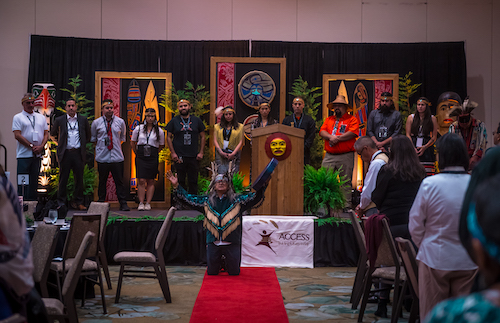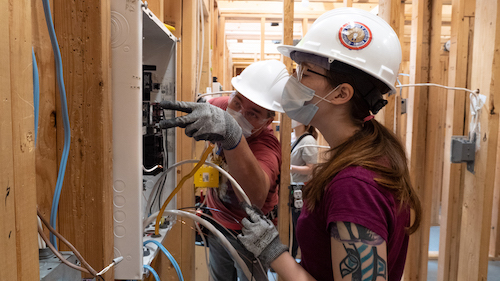When Wakenniosta Cooper graduated from her apprenticeship in August, she wasn't just part of the Electrical Joint Training Committee's first Indigenous-specific cohort. She was already a decorated tradeswoman, having won Apprentice of the Year in 2021.

|
| Students graduated in August from the Electrical Joint Training Committee's first Indigenous-specific cohort, which was commemorated with a witnessing ceremony, an Indigenous practice where community members are called to serve as keepers of history and witness an event of historical significance. Photo credit: Jessie Robertson Photography
|

|
| The Indigenous-specific cohorts proved so successful that the program has been expanded to cover all levels of the apprenticeship. "Now they are in a position to become journey persons in the most academic of the skilled trades, one that only about 50% of all Canadians complete. The sky is the limit for them," said Buddy Cardinal, ACCESS director of trades and apprenticeship.
|
“Wakenniosta is one of our star students in the program," said Vancouver, British Columbia, Local 213 Business Manager Jim Lofty. "She has really proven to be an excellent worker and IBEW member."
This year's cohort is the culmination of a program started in 2017 to bring in more Indigenous people to the EJTC and Local 213. Prior to that, they were competing with other organizations for the same candidates, EJTC Managing Director Phil Davis said.
Instead of fighting for the same pool of people, they decided to expand it by offering a pathway to the trade for potential apprentices and fill their largest knowledge gaps. Working with SkillPlan, the training arm of the British Columbia Building Trades, they designed an eight-week Entry Level Trades Training course with two goals. First, it targets math and science, two areas where many struggled to meet requirements, and second, it prepares participants for the apprenticeship.
"The curriculum was developed around the specific needs of folks that may not have our prerequisites," Lofty said. "A lot of Indigenous youth may only have a Grade 10 math and science foundation, oftentimes due to socioeconomic circumstances or their geographic location."
Building on previous attempts to recruit Indigenous students that weren't as successful as hoped, the EJTC partnered with a leading organization in Canada, the Aboriginal Community Career Service Society, or ACCESS, to handle the screening and recruitment, as well as provide resources like lab equipment to the EJTC.
"We work with spectacular partners, and ACCESS is definitely one of them," Davis said. "Without them, we couldn't do this."
ACCESS also provides wraparound services for candidates, from help with resume writing and interview skills to counseling, childcare and startup tools.
"These students have faced challenges including the impact of COVID-19, the emotional toll of discovering Indigenous mass burials, family difficulties, homelessness and the lack of traditional prerequisites," said Buddy Cardinal, ACCESS director of trades and apprenticeship.
The program proved so successful that it has been expanded to cover additional levels of the apprenticeship. Initially, a student would graduate and then go straight to the second year of the traditional apprenticeship, which is taught by private technical institutions. But those larger settings didn't always provide the one-on-one attention that proved so successful in the entry-level program. Without it, many students started to slip through the cracks, Lofty said. They went back to what worked and started offering second- and third-year Indigenous cohorts, again with help from ACCESS and other partners. It paid off: They had pass rates of 85% and 90%.
"We were able to develop curricula in our training facility that allowed for smaller, more boutique-style classes that offered more time for individual student needs, and the apprentices had a better experience," Lofty said. "It speaks well to how great our staff and instructors are."
These successes led to a fourth-year Indigenous cohort, which had similar results.
"These apprentices have defied the odds," Cardinal said. "Now they are in a position to become journey persons in the most academic of the skilled trades, one that only about 50% of all Canadians complete. The sky is the limit for them."
And those apprentices are now serving as role models and inspirations for other Indigenous Canadians to consider the trades.
"Some have said they previously didn't see being an electrician as a possibility for them. Now they're going back and telling others," Davis said.
Training more Indigenous apprentices will increase the likelihood that when projects come to their area, they'll get the high-wage jobs, further benefiting their communities, Lofty said.
"We've witnessed Indigenous nations gain significant work in their region but miss out on the real hours of work and development for their people," he said. "Projects of varying scope and size may pop up in an area with many Indigenous communities and potential workers, but they would end up doing security, food services, housekeeping or tasks that pay less than what the skilled trades could offer for long-term careers."
For Cooper, the Indigenous cohort gave her more than just a top-notch education. It provided a sense of community.
"I moved away from my home in Quebec over 10 years ago," Cooper said. "I felt alone and misunderstood without my family and friends. This course not only gave me a career but lifelong friends that I cherish."
Cooper accompanied Lofty to Ottawa when Local 213 was invited by the Prime Minister's office to attend President Joe Biden's address to Parliament.
"It was a very interesting experience," she said. "I don't think anyone in my family has met a prime minister before. I feel like I'm carving a path for future Indigenous generations."
It's not just the students who are benefiting from new ties, either. Cardinal, Davis and Lofty all said the program's success was possible because everyone worked together, toward the same goal.
"It took the forming of mutually beneficial partnerships between the EJTC, Local 213, employers, regulators, government and, most importantly, the Indigenous community," Lofty said. "If you can utilize others to open doors, channel funding or bring skills and resources to bear, you won't have to do it by building from the ground up. Too often, unions or organizations try to do it all on their own, only to fail in the end."
That success was commemorated with a witnessing ceremony, an Indigenous practice where community members are called to serve as keepers of history and witness an event of historical significance.
There was also a blessing ceremony, Cardinal said, which is considered a high honor.
"To celebrate this momentous achievement, as an Indigenous organization serving urban Indigenous apprentices, we wanted to honor their accomplishment through traditional Indigenous protocols," Cardinal said. "That includes prayer, blessings, song, dance and a shared meal embracing the concept of all our relations."
"We are holding witness to the tremendous work they have done not only for themselves, but for their families and communities, and we're acknowledging them for their efforts," Cardinal said. "There is, however, much work to do."